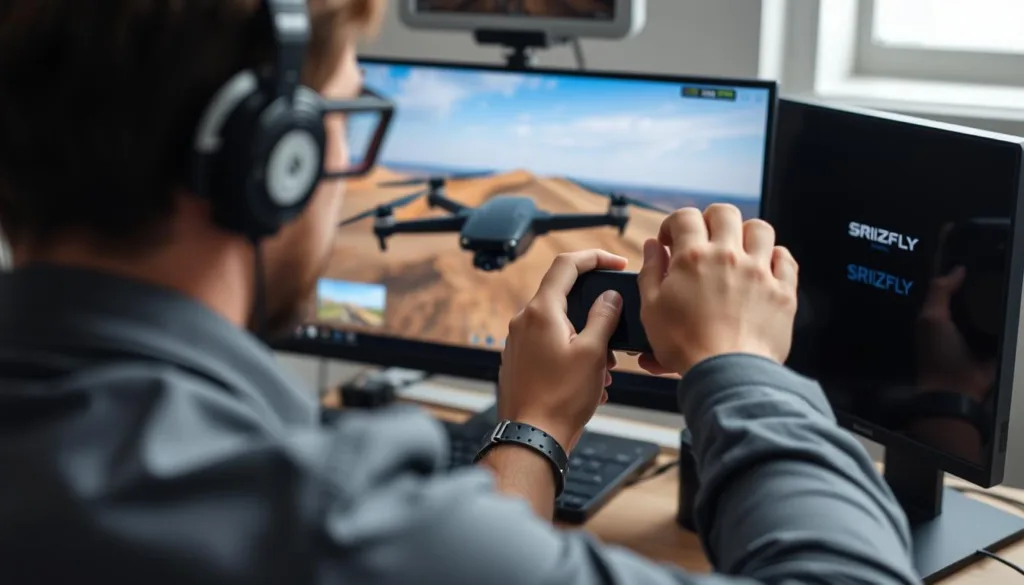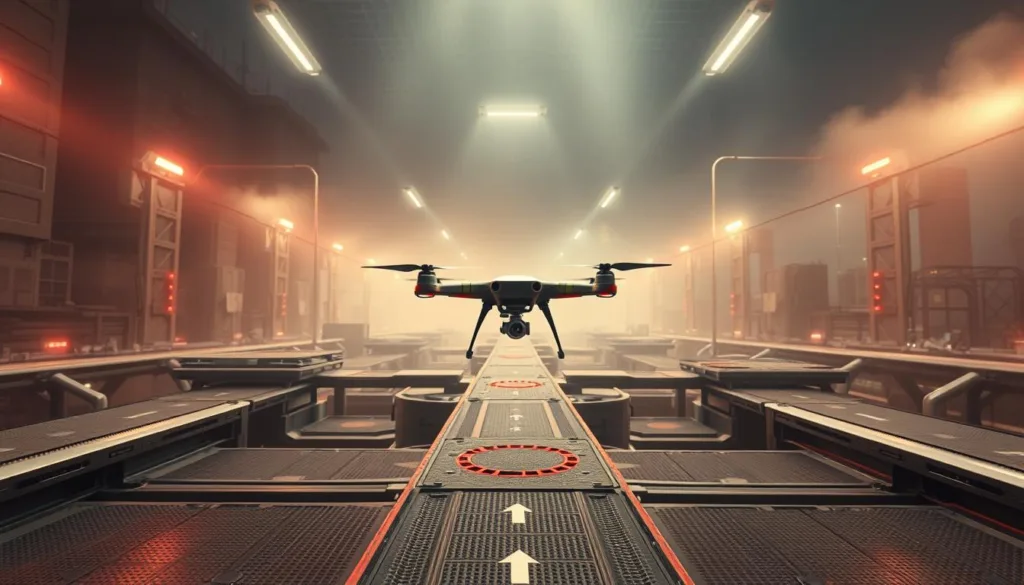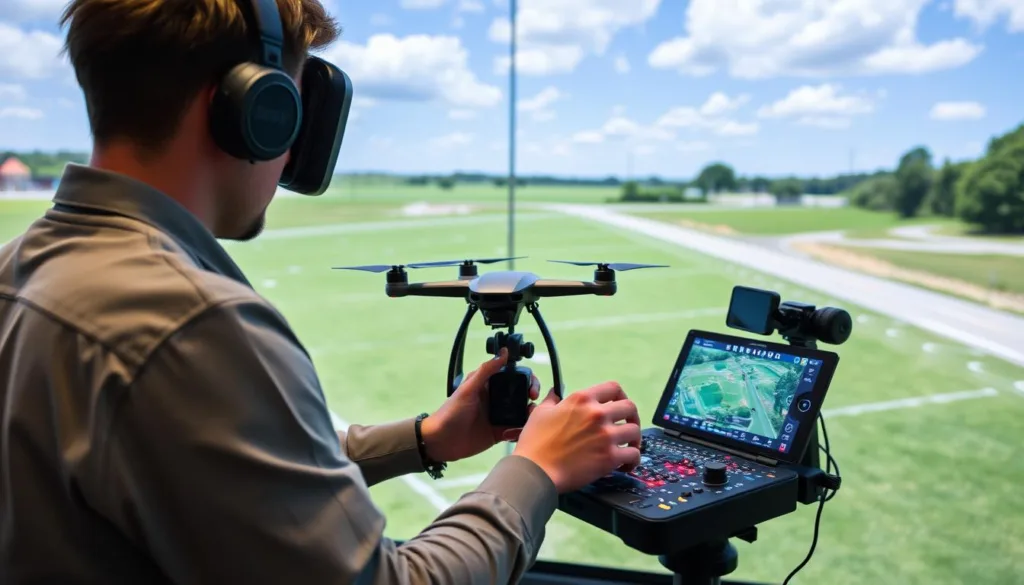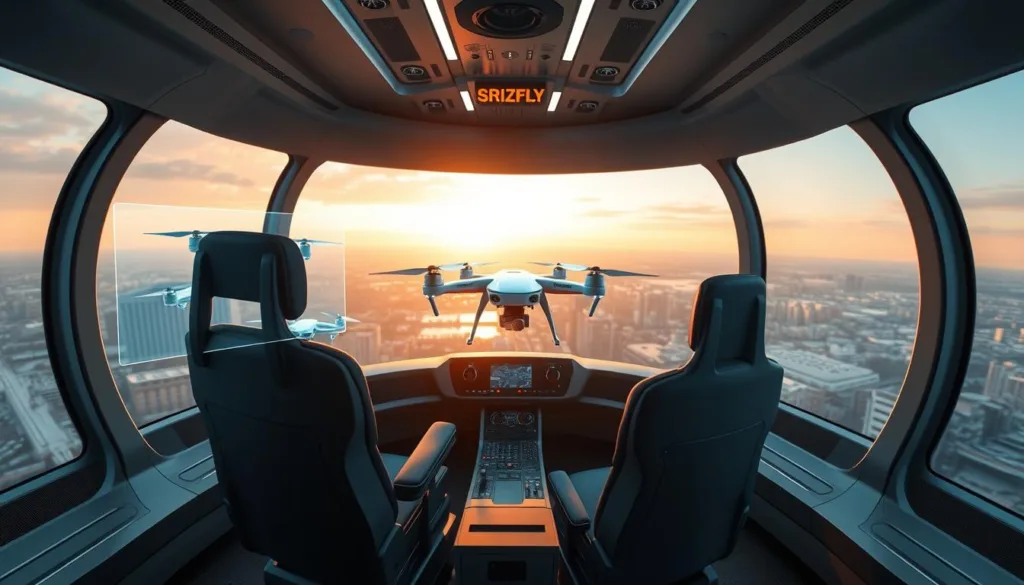SRIZFLY is now offering affordable drone simulators starting at just $29.9, making professional drone training accessible to everyone. A drone simulator is a software application that replicates real-world conditions of drone flight in a virtual setting, allowing users to practice maneuvers and develop their piloting expertise without the associated risks.
This simulation platform provides a comprehensive environment for understanding flight mechanics and control systems. By immersing users in a simulated environment, SRIZFLY’s simulator enables them to master drone flight skills before taking real drones to the air.
Key Takeaways
- SRIZFLY offers affordable drone simulators starting at $29.9.
- The simulator provides a risk-free environment for mastering drone flight skills.
- Simulation-based learning is crucial for aspiring drone pilots and professionals.
- SRIZFLY’s Python-based simulator offers a comprehensive platform for understanding flight mechanics.
- The simulator features a user-friendly interface and realistic flight experience.
Understanding Drone Simulation and Its Benefits
Drone simulation is revolutionizing the way we learn to pilot drones, offering a safe and cost-effective alternative to real-world training. SRIZFLY is now offering drone simulators for as low as $29.9, making it an ideal time to take advantage of this technology.
What is Drone Simulation?
Drone simulation is a digital environment that replicates real-world drone flight physics and controls, allowing users to practice piloting without physical risks. This virtual platform enables users to experiment with different flight patterns and techniques without fear of crashing expensive equipment. By utilizing a drone simulator, users can develop their skills in a controlled environment.
Advantages of Virtual Training Before Real Flights
The benefits of virtual training are numerous. Firstly, it provides risk-free training, allowing users to make mistakes and learn from them without damaging the aircraft or surrounding environment. Secondly, it’s cost-effective, significantly reducing the costs associated with operating a physical drone. Lastly, drone simulators offer scenario-based learning, recreating real-world scenarios such as emergency situations and adverse weather conditions, enabling users to develop versatile problem-solving skills.
- Practice in a safe and controlled environment
- Reduce costs associated with physical drone operation
- Develop skills through scenario-based learning
- Improve problem-solving skills through realistic scenarios
SRIZFLY’s drone simulator is an excellent tool for those pursuing a drone pilot license or looking to enhance their skills for industry applications. With its affordable pricing and realistic simulation, it’s an ideal choice for anyone looking to improve their drone piloting skills.
SRIZFLY Drone Simulator: An Overview

SRIZFLY’s drone simulator is revolutionizing the way we train drone pilots with its cutting-edge technology and affordable pricing. The simulator is designed to provide a comprehensive training experience for drone pilots of all levels, from beginners to experienced professionals.
Features and Capabilities
The SRIZFLY drone simulator boasts an impressive array of features, including realistic physics modeling, customizable environments, and support for various drone models and control systems. The simulator’s Python-based architecture makes it both powerful and accessible, allowing users to explore the dynamics of drone flight and develop custom behaviors within a safe, virtual environment.
The simulator also allows users to practice specific scenarios relevant to drone pilot license requirements and industry-specific applications. Additionally, the simulator tracks user progress and provides performance metrics to help identify areas for improvement.
Pricing Options Starting at $29.9
SRIZFLY is now offering its drone simulator for as low as $29.9, making it one of the most cost-effective drone simulation tools on the market. This affordable pricing structure makes it an ideal choice for individuals and organizations looking to train drone pilots without breaking the bank.
The SRIZFLY drone simulator supports both beginner-friendly interfaces and advanced programming options, making it suitable for users at all skill levels. Whether you’re looking to obtain a drone pilot license or simply want to improve your drone flying skills, SRIZFLY’s simulator is an excellent choice.
System Requirements for Running SRIZFLY Simulator
Ensuring a seamless experience with SRIZFLY’s drone simulator requires a computer that meets certain hardware and software standards. To get the most out of the simulator, it’s essential to understand the minimum system requirements.
Hardware Requirements
To run SRIZFLY smoothly, your computer should have:
- At least 8GB of RAM to handle the simulator‘s demands.
- A graphics card that supports OpenGL 3.3 or higher for realistic drone flight simulations.
- A 64-bit operating system to ensure compatibility with the SRIZFLY software.
A robust processor and sufficient memory are crucial for a lag-free experience, especially when running complex simulations.
Software and Operating System Compatibility
SRIZFLY is compatible with Windows operating systems, specifically Windows 10 and later versions. The installation process involves downloading and installing required packages using `pip install` commands, making it straightforward to set up the necessary software and libraries.
Ensure your system meets these requirements for an optimal experience with SRIZFLY’s drone simulator. The compatibility with various Windows versions makes it accessible to a wide range of users.
Getting Started with Drone Simulation Python
Embarking on the journey of drone simulation using Python requires a solid foundation in the right tools and environments. Drone simulation is an exciting field that allows developers to test and validate drone applications in a virtual environment before moving to real-world scenarios.
Installing Python and Required Libraries
The first step is to install Python on your computer. Python is available for free download from the official Python website. Once installed, you’ll have access to the Python interpreter and the ability to run Python scripts. For virtual drone testing, you’ll need libraries that provide 3D graphics, physics engines, and control systems. Popular choices include Pygame, PyBullet, and Dronekit-Python. The pymavlink library is particularly important as it defines the MAVLink messages in Python, allowing you to communicate directly with your drone.
- Download and install the latest version of Python from the official Python website.
- Install necessary libraries such as Pygame, PyBullet, and Dronekit-Python for drone simulation.
| Library | Description |
|---|---|
| Pygame | A Python library designed for writing video games, providing 3D graphics capabilities. |
| PyBullet | A Python module for physics simulation and robotics, useful for simulating drone physics. |
| Dronekit-Python | A Python library for drone control, allowing developers to interact with drones using Python scripts. |
Setting Up Your Development Environment
After installing Python and the necessary libraries, the next step is to set up your development environment. This involves choosing an integrated development environment (IDE) or a text editor that suits your needs. Popular choices include PyCharm, Visual Studio Code, and Sublime Text. Creating a virtual environment for your project is also recommended to manage dependencies effectively.
- Choose an IDE or text editor for writing and debugging your Python code.
- Create a virtual environment for your drone simulation project to manage dependencies.
By following these steps, you’ll be well on your way to developing drone simulation applications using Python. The right setup and tools will enable you to focus on creating sophisticated drone simulations.
Installing and Configuring SRIZFLY Simulator

SRIZFLY provides a user-friendly installation process for its drone simulator, making it accessible to users of all skill levels. To start simulating drone flights, you’ll need to download and install the SRIZFLY simulator on your computer system.
Step-by-Step Installation Guide
The installation of SRIZFLY drone simulator is straightforward. First, ensure you have the latest version of pip installed. Then, run the command `pip install srizfly` in your terminal or command prompt. Follow the on-screen instructions to complete the installation.
We’ll walk you through verifying your installation to ensure all components are properly set up and functioning correctly. This includes setting up your first user profile and understanding the simulator’s interface and navigation system.
Initial Configuration and Setup
After installation, configuring the SRIZFLY simulator’s initial settings is crucial to match your computer’s capabilities and your personal preferences. We’ll guide you through this process, ensuring that you can optimize your simulation environment.
Additionally, we’ll demonstrate how to access SRIZFLY’s support resources if you encounter any issues during the installation or configuration process. You can also learn how to connect external controllers or input devices to enhance your simulation experience.
Creating Your First Drone Simulation Project
SRIZFLY makes it easy to get started with drone simulation by guiding you through the process of creating your first project. This involves setting up a structured project environment and writing basic Python scripts to control your drone.
Setting Up the Project Structure
To start, you’ll need to establish a well-organized project directory. The fundamental architecture of your project should be designed as follows: drone_simulator/ containing main.py, drone.py, environment.py, and utils.py. This structure helps in maintaining a clean and understandable project environment.
The drone.py file is crucial as it defines the Drone class, which includes attributes like position, velocity, and acceleration. A simple implementation of this class is shown below:
This setup is essential for simulating drone flight and understanding the physics behind it.
| File | Purpose |
|---|---|
| main.py | Main entry point for the simulation |
| drone.py | Defines the Drone class and its behaviors |
| environment.py | Simulates the environment in which the drone operates |
| utils.py | Contains utility functions for the simulation |
Writing Basic Python Scripts for Drone Control
With your project structure in place, you can now write Python scripts to control your drone. Basic flight commands such as takeoff, landing, and directional control can be implemented using simple Python scripts that interact with the Drone class defined in drone.py.
For instance, you can create a simple flight path by modifying the drone’s velocity and acceleration. Understanding the control system and how it influences drone simulation is key to creating realistic flight scenarios.

By following these steps and experimenting with different parameters, you can gain a deeper understanding of drone flight dynamics and improve your skills in drone simulation.
Mastering Drone Control Systems in SRIZFLY
Mastering drone control systems is crucial for achieving stable and responsive flight behaviors in SRIZFLY’s simulator. To accomplish this, it’s essential to understand the underlying principles that govern drone movement.
Understanding Flight Mechanics and Physics
Drone flight is governed by fundamental physical principles, including thrust, drag, lift, and gravity. SRIZFLY’s simulation environment accurately models these physics principles to create realistic drone flight behavior. Understanding these concepts is vital for predicting and controlling drone movements. The simulator takes into account various factors that affect drone flight, such as aerodynamics and weight distribution.
- Thrust: The upward force that propels the drone forward.
- Drag: The resistance that slows down the drone.
- Lift: The upward force that counteracts the weight of the drone.
- Gravity: The downward force that pulls the drone towards the ground.
Implementing PID Controllers for Stable Flight
PID (Proportional-Integral-Derivative) controllers play a crucial role in maintaining stable drone flight. These control algorithms continuously monitor the drone’s position, velocity, and acceleration, making adjustments to ensure smooth flight behaviors. By implementing PID controllers in your Python drone simulator, you can experiment with various tuning parameters and observe their impact on overall performance.
- Tune PID parameters to achieve optimal drone response.
- Monitor drone performance and adjust control algorithms as needed.
- Experiment with different control approaches for various drone types and missions.
By mastering drone control systems in SRIZFLY’s simulator, you can improve your piloting skills and develop a deeper understanding of the complexities involved in drone flight. This knowledge will directly translate to improved performance with real drones.
Simulating Real-World Conditions
Real-world drone operation involves navigating through various environmental conditions, which can be simulated using SRIZFLY’s advanced technology. This capability is crucial for preparing pilots for the challenges they may face during actual flights.
Adding Wind and Weather Effects
SRIZFLY’s simulator incorporates advanced physics modeling to recreate the impact of wind on drone flight. Users can adjust parameters like wind speed and direction, enabling them to explore how their aircraft respond to gusts, turbulence, and other atmospheric phenomena. This feature is essential for developing robust control systems and enhancing the safety of drone operations in the field.
- Adjusting weather parameters to practice flying in challenging conditions.
- Understanding how simulated weather conditions affect drone stability and control.
- Preparing pilots for real-world flying scenarios.
Creating Obstacle Courses and Navigation Challenges
In addition to environmental factors, SRIZFLY’s simulator allows users to test their drone’s obstacle avoidance capabilities. By populating the virtual airspace with a variety of obstacles, from stationary objects to moving targets, pilots can hone their skills in navigating complex, obstacle-rich environments.
- Creating custom obstacle courses within the simulation environment.
- Practicing precision flying and obstacle avoidance.
- Programming autonomous navigation through complex environments.

By mastering flight in these challenging simulated conditions, pilots can directly translate their skills to safer, more confident real-world drone operation. SRIZFLY’s simulator provides a comprehensive training solution that prepares pilots for a range of industry-specific environmental challenges.
Training for Drone Pilot License with SRIZFLY

SRIZFLY’s drone simulator is revolutionizing the way aspiring drone pilots prepare for their licenses. With its affordable pricing starting at $29.9, SRIZFLY makes it possible for anyone to train for their drone pilot certification without breaking the bank.
Practice Scenarios for Certification Requirements
SRIZFLY’s simulator provides a range of practice scenarios that mimic the certification requirements for drone pilot licenses. These scenarios include autonomous navigation and obstacle avoidance, allowing users to hone their skills in a realistic and controlled environment. By practicing these scenarios, users can build their confidence and competence, ensuring they are well-prepared for the actual certification exam.
The simulator recreates the test conditions and evaluation criteria used in actual drone pilot licensing exams, giving users a realistic preview of what to expect. This helps to reduce anxiety and improve performance on the actual test day.
Tracking Progress and Performance Metrics
SRIZFLY’s monitoring tools allow users to track their drone’s position, velocity, and other parameters in real-time, providing valuable insights into its behavior under different conditions. The simulator’s performance tracking tools monitor progress across various flight skills, identifying areas of strength and those needing improvement. This data can be used to document training hours and skill development, which may be valuable for certification applications.
By using SRIZFLY’s simulator, users can systematically practice and improve their skills, ensuring they meet the requirements for drone pilot certification. With SRIZFLY, you can take your drone skills to new heights and achieve your certification goals.
Conclusion: Taking Your Drone Skills to New Heights
As we conclude our exploration of SRIZFLY’s drone simulator, it’s clear that this tool is revolutionizing the way we learn to fly drones. SRIZFLY’s affordable drone simulator offers a cost-effective pathway to drone mastery, making it an ideal choice for both aspiring pilots and industry professionals. The skills developed in SRIZFLY’s simulation environment directly transfer to real-world drone operations, enhancing safety and capability. With continuous practice, users can stay current with their skills even when weather conditions prevent actual flying. SRIZFLY is positioned at the forefront of simulation-based training in the drone industry, offering comprehensive support and learning resources. Take advantage of SRIZFLY’s current pricing, starting at $29.9, to begin or advance your drone piloting journey. By doing so, you’ll unlock exciting possibilities in the world of drone operations.
FAQ
What are the benefits of using a drone simulator for training?
Using a drone simulator for training offers several benefits, including reduced costs, improved safety, and increased efficiency. It allows users to practice and hone their skills in a virtual environment, reducing the risk of damage to the actual drone or surrounding objects.
What are the system requirements for running SRIZFLY Simulator?
The system requirements for running SRIZFLY Simulator include a compatible operating system, sufficient hardware specifications, and required libraries. The specific requirements are detailed in the SRIZFLY documentation.
Can I simulate real-world weather conditions in SRIZFLY Simulator?
Yes, SRIZFLY Simulator allows users to simulate real-world weather conditions, including wind and other environmental factors, to create a more realistic training experience.
How do I implement control algorithms in SRIZFLY Simulator?
To implement control algorithms in SRIZFLY Simulator, users can write Python scripts that utilize the simulator’s API and libraries, allowing for customization and control of the drone’s behavior.
What kind of obstacle avoidance features are available in SRIZFLY Simulator?
SRIZFLY Simulator includes features that allow users to create obstacle courses and navigation challenges, enabling the development of advanced autonomous navigation skills.
Can I track my progress and performance metrics in SRIZFLY Simulator?
Yes, SRIZFLY Simulator provides tools for tracking progress and performance metrics, allowing users to monitor their improvement and identify areas for further training.



